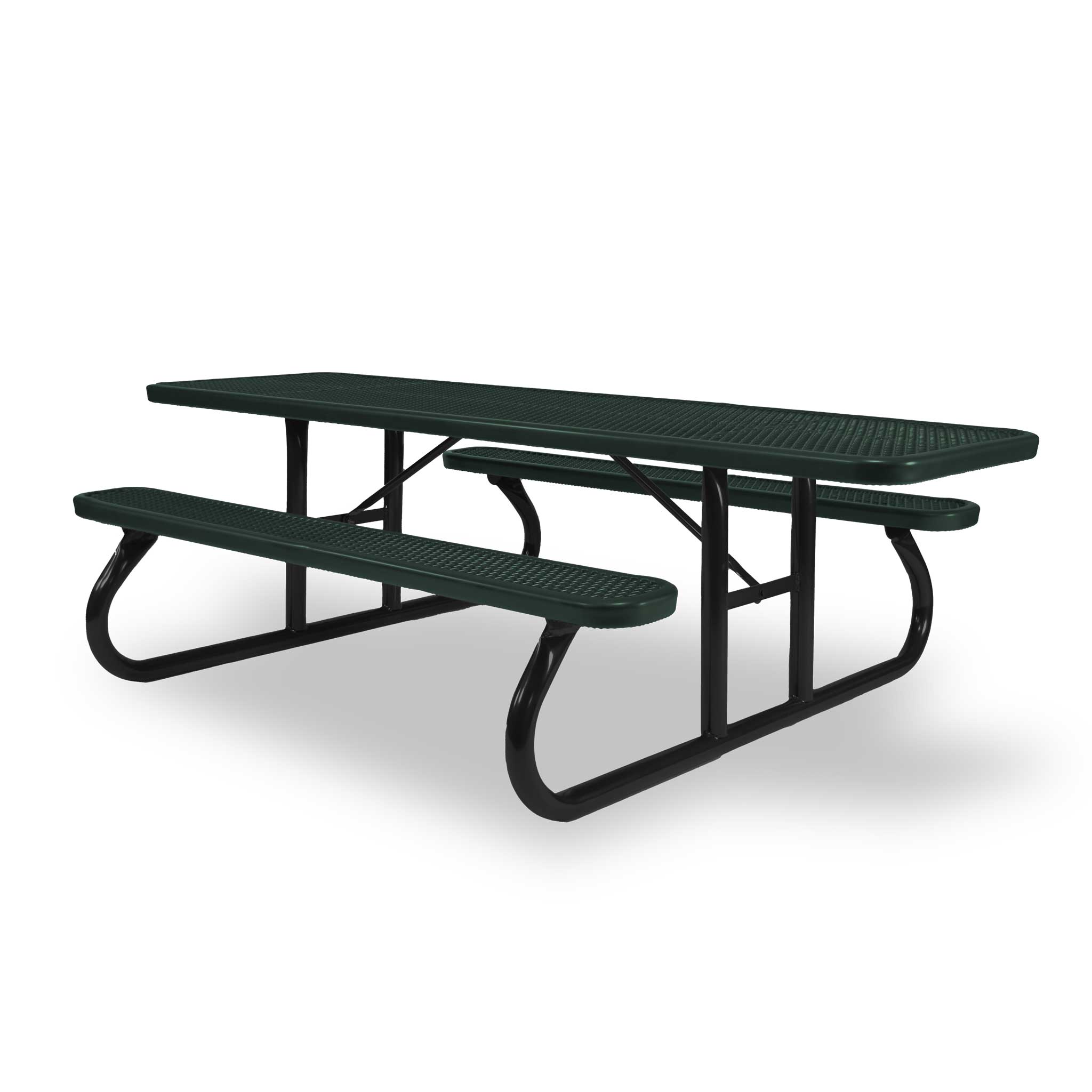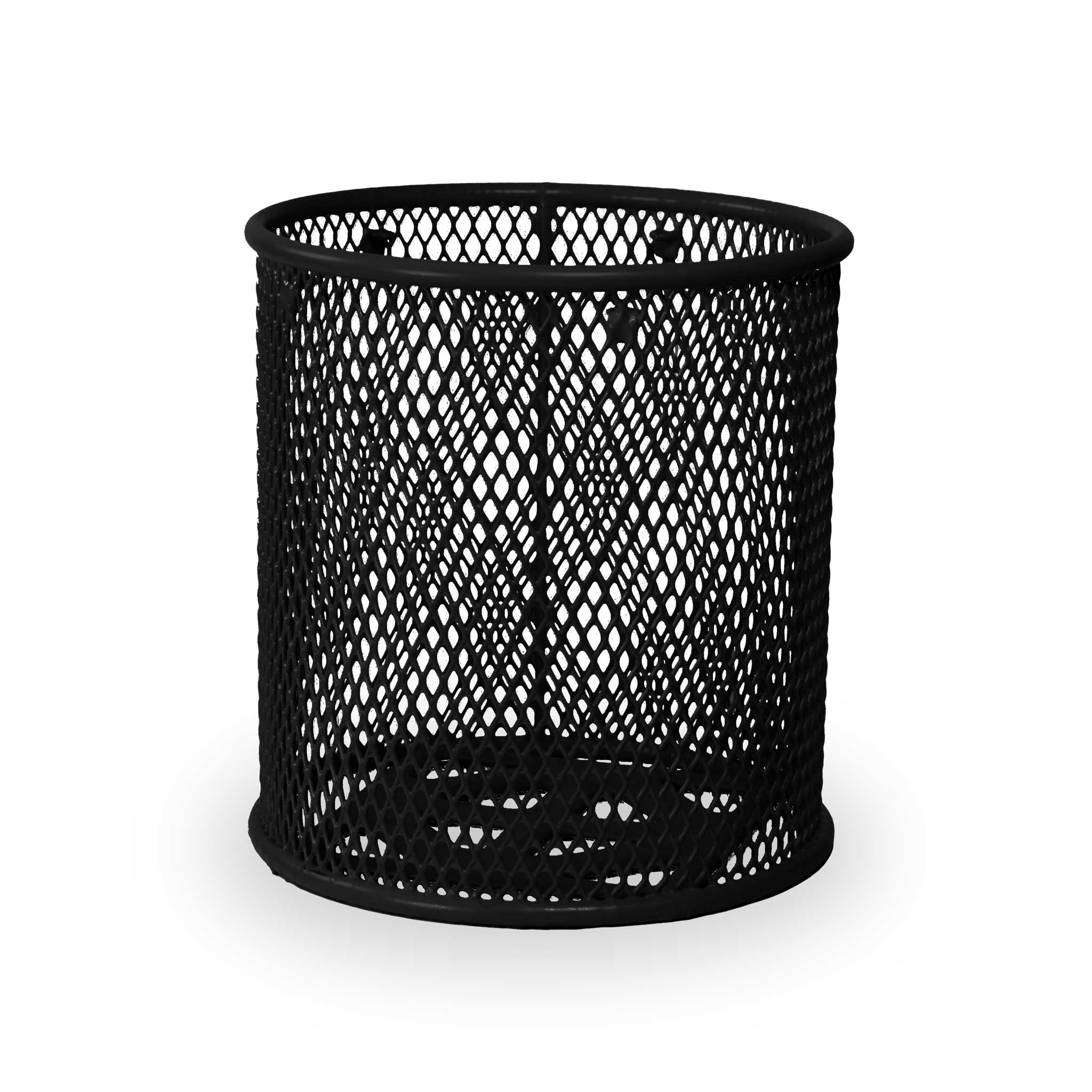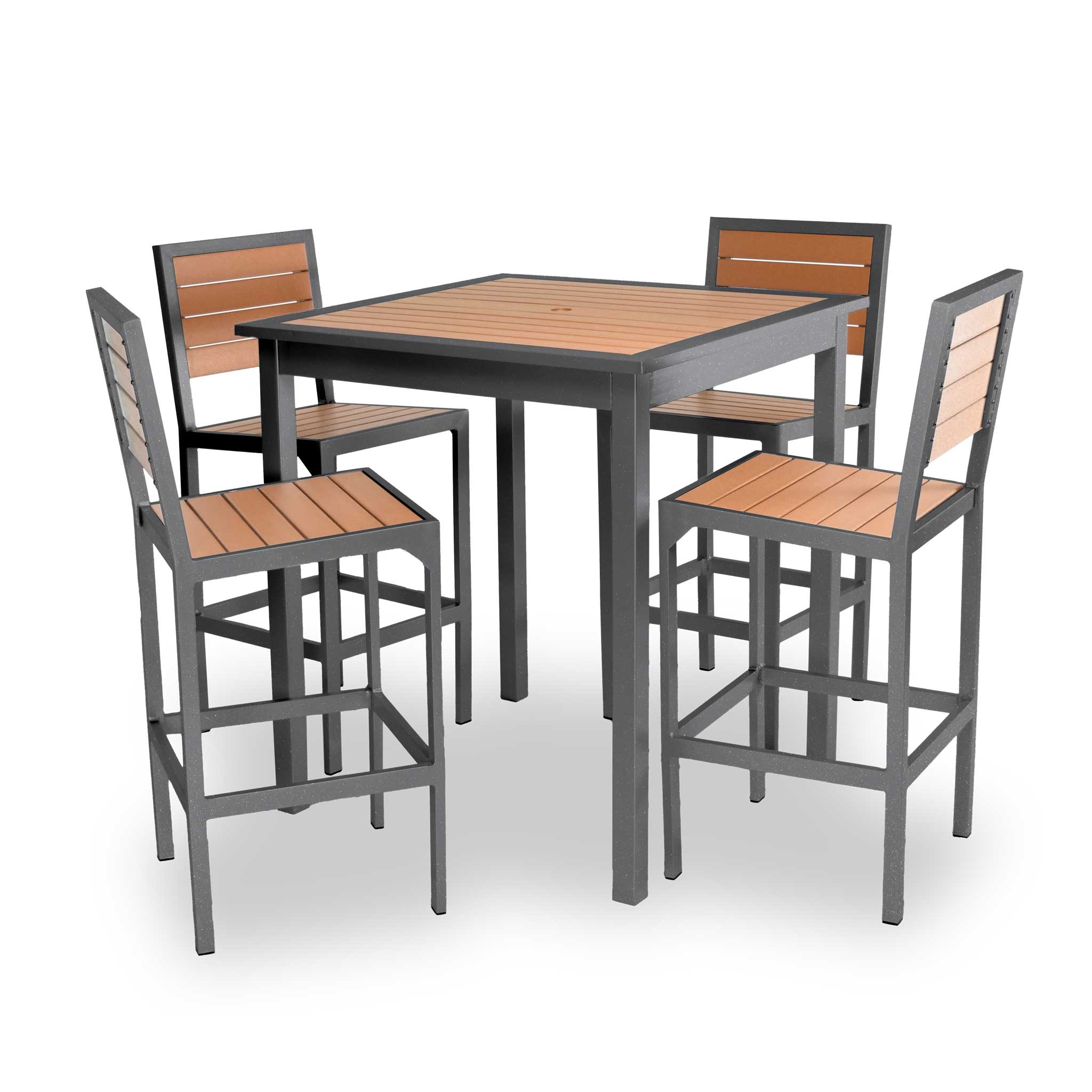Trash Receptacle Buyer’s Guide
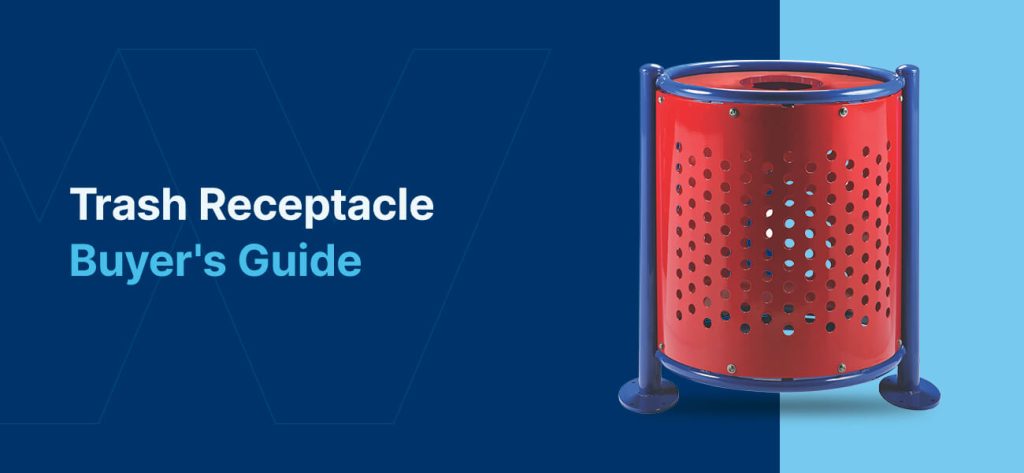
Product Guide | Mar 25, 2022
Whenever people gather, they need a place to put their trash. People picnicking in a park need somewhere to toss their used napkins and food waste when they’re finished. People attending sporting events or concerts need somewhere to toss their empty cups and utensils.
Whether you manage an amusement park, stadium or public park, having enough trash receptacles is a must to keep the venue looking clean and to reduce the risk of a pest infestation. Having enough places for people to toss their trash also reduces litter.
Along with having enough trash cans, it’s important to choose receptacles that work with your location. This buying guide will show you how to choose trash receptacles to encourage people to put their garbage in the right spot and to keep a public outdoor area looking great.
Read the full article or skip to a specific section:
- Trash Receptacle Styles
- Trash Receptacle Materials
- What to Consider When Choosing Materials
- Trash Receptacle Lids
- Choosing the Right Type of Trash Receptacle for Your Business
- Choose Your Trash Receptacle from Wabash Valley Furnishings
Trash Receptacle Styles
When you’re choosing trash cans, consider several things. First, think of the purpose the bin will serve. Next, consider the shape and size of the receptacle or the size of the area you’ll be putting it in.
While function should come first where trash cans are concerned, form also matters. You want to choose styles that coordinate well with the overall look of your outdoor area.
Purpose
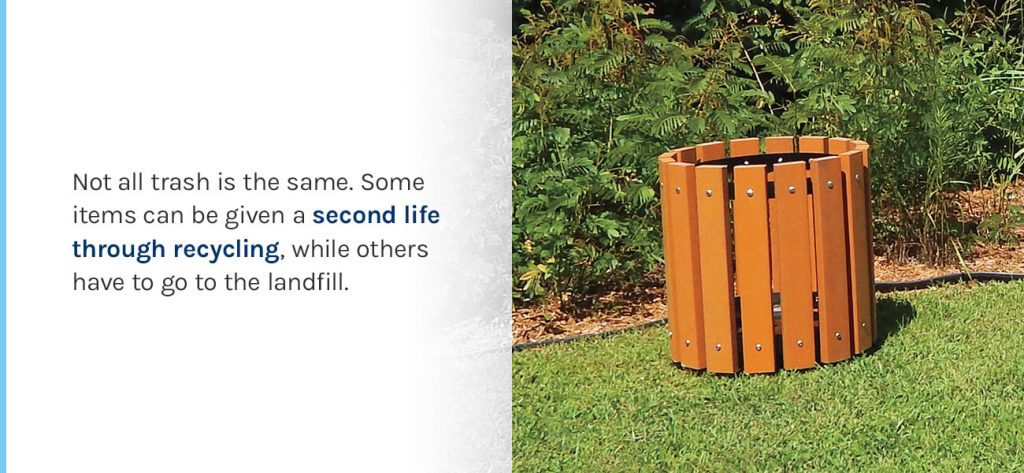
Not all trash is the same. Some items can be given a second life through recycling, while others have to go to the landfill. Make it easy for visitors to sort their trash by providing multiple receptacles. Some options include:
- Outdoor trash bins: Outdoor trash receptacles are available in several sizes and materials, as well as in different colors and shapes. The bins collect trash, such as food wrappers, food scraps and other bits and pieces people decide they no longer want to hold on to. Outdoor receptacles tend to be made from sturdy materials and can withstand exposure to heat or cold, rain and wind.
- Outdoor recycling bins: If you recycle, it’s a good idea to give people a chance to separate recyclable items from their trash. Recyclable items can include plastic or glass bottles, aluminum cans and newspapers. Often, it’s a good idea to put a recycling receptacle next to one for trash and label each one clearly.
- Ash urns: While many areas ban smoking, if yours hasn’t, it’s a good idea to give smokers a place to toss their cigarette butts safely. Although the number of people who smoke is declining, cigarette butts remain the most frequently littered items. Providing smokers with a place to put their cigarettes keeps your area looking clean and reduces fire risk. Ash urns offer just the place.
Shape and Size
Trash and recycling receptacles come in several sizes and shapes. If you’re buying trash bins for an area with a lot of foot traffic, it makes sense to go for the largest size available, such as 32 or 55 gallons. If you’re installing several trash receptacles in the same location, such as around a baseball diamond or next to benches in a playground, a smaller size, such as 10 or 22 gallons, might be sufficient.
How frequently you empty the trash receptacles should also influence your size decision. Smaller bins might need to be emptied more frequently than larger ones. If a receptacle is too full, people will often pile their trash around it, which affects the aesthetics of your location and can lead to pest problems.
Other style considerations to think about when choosing trash bins include:
- Round vs. square: Whether you choose round or square for your trash bins is a matter of aesthetics and practicality. If you’re lining up several bins in a row, you’ll save space if they are square or rectangular rather than round. Some people find round shapes more pleasing than squares ones, though.
- Flat top vs. lidded: A flat top trash can be completely open or have a rain bonnet to keep the contents from getting wet. A lidded trash can might have an opening that people need to push open. Some people find push-open lids to be unhygienic and might hesitate to use them. Flat top trash cans can be easier to use but there’s also a chance that trash will fall out or start to pile up if the bin is too full.
- Pole vs. surface mount: Pole-mounted receptacles tend to be smaller and have a significantly smaller footprint. They also require poles, such as a lamppost or street sign. Surface–mounted trash bins can be secured to the ground to prevent theft. They can be ideal for areas with more foot traffic.
- Slats vs. perforated: Like square vs. round, slats vs. perforated is mostly an aesthetic choice. Consider the other types of furnishings you’re using and how the trash bins coordinate with them.
- Tapered vs. straight: Tapered trash receptacles are narrower at the bottom and might be more prone to tip over in very windy conditions. You can counteract that by mounting them to a surface. Straight bins tend to have a bigger footprint and more volume inside. In large part, straight-sided vs. tapered is an aesthetic decision. Choose the style that coordinates best with the rest of the area’s furnishings.
Trash Receptacle Materials
Outdoor trash bins need to be made from a material that can withstand all types of weather. The more weather-resistant the material is, the longer the trash receptacle will last.
You’ll also want to think about how the material looks and whether it coordinates with your organization’s overall aesthetic. Some options include:
Powder-Coated Metal
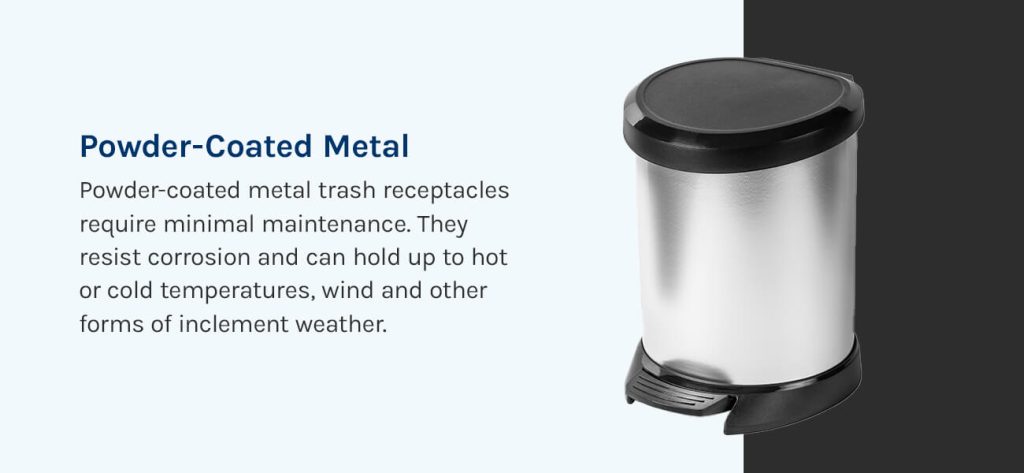
Metal is a sturdy, durable material that can last for years with the right care. The drawback of metal is that certain types can rust if exposed to water.
Powder coating adds an extra layer of protection to steel and other metal types. During the powder coating process, finely ground pigment and resin are mixed together, electrically charged, then sprayed over metal. The coating provides a long-lasting protective finish that’s also aesthetically pleasing.
Powder-coated metal trash receptacles require minimal maintenance. They resist corrosion and can hold up to hot or cold temperatures, wind and other forms of inclement weather.
You have a lot of color choices if you choose powder-coated metal, such as blue, red, green and silver. Since the pigment is mixed with resin, powder coating tends to create a finish that is fade resistant. Your trash receptacles will look bright and fresh even after years of use.
Plastisol Coating
Plastisol coating has some things in common with powder coating. It helps to make metal more durable and weather resistant. It’s also available in a range of colors and perforation patterns.
While powder coating is made from resin and powdered pigments, Plastisol is made from polyvinyl chloride (PVC). At room temperature, it’s a liquid. It turns into a rubber-like material when heated and allowed to cure.
Along with resisting rust and corrosion, Plastisol is also chip-resistant and UV-resistant. Its strength makes it an ideal choice for outdoor settings and for use in playground areas or any other area when a trash receptacle might be kicked or hit.
Plastic
Plastic is another option for trash receptacles. Plastic is water-resistant and can be durable. Depending on the type of plastic used, it might not be UV-resistant, meaning the color of a trash bin can fade after years in the sun.
Plastic receptacles tend to be solid, which can be a drawback, as they might not let liquids drain away from the trash.
What to Consider When Choosing Materials
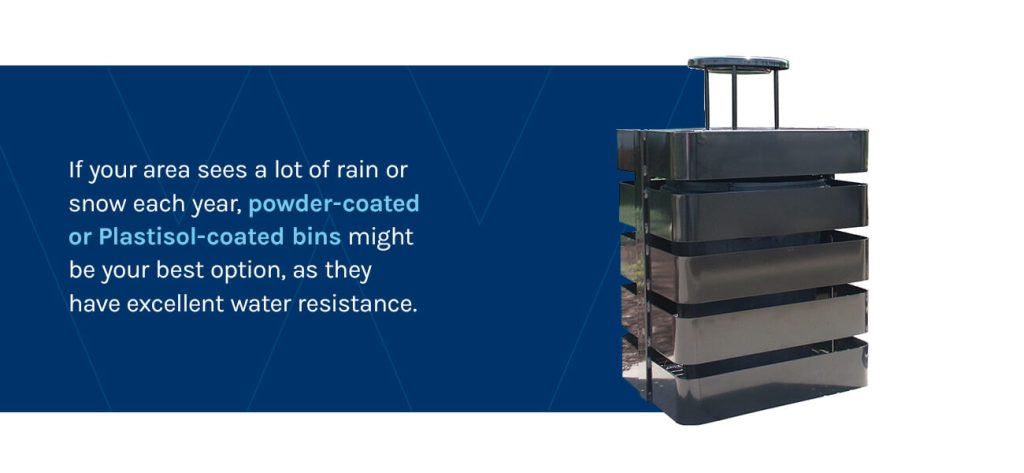
Keep the weather conditions and visitor behavior in mind when choosing materials for your trash receptacles. If your area sees a lot of rain or snow each year, powder-coated or Plastisol-coated bins might be your best option, as they have excellent water resistance. Plastic can also withstand rain and moisture but not as well as powder- or Plastisol-coated materials.
Another thing to consider is the amount of contact the bins will have with people. If you’re choosing receptacles for a sports field or play area, they will likely get a lot of abuse from kids or balls running into them. If you’re looking for trash bins to put near bonfire pits or barbecues, look for options that can withstand high temperatures or that aren’t likely to melt.
Looks also matter. Some materials, such as coated metals, come in a wider range of color choices than others. The material you choose influences the style of the receptacle overall.
Trash Receptacle Lids
Lid or no lid is an important question to answer when choosing trash receptacles. Whether there’s a lid or not can affect how likely people are to use the trash bin. Lids can also offer some protection against the elements.
Some options to choose from include:
Flat Top
Sometimes called a pitch in style, a trash receptacle with a flat top doesn’t have a covering over the top. The design makes it easy for people to throw their garbage in the bin as they pass by.
Another benefit of a flat top lid style is that it’s often perceived as more hygienic than other styles. It’s a touch-free trash bin, which might encourage people to use it more.
A drawback of the flat top style is that it leaves the bin completely open. Squirrels and other pests can get into the trash and dig through it looking for food. A windy day can cause the trash to fly out of the bin, while rain can fill up the bin with water. There’s also a chance that people will use the receptacle too much and that it will overflow with garbage.
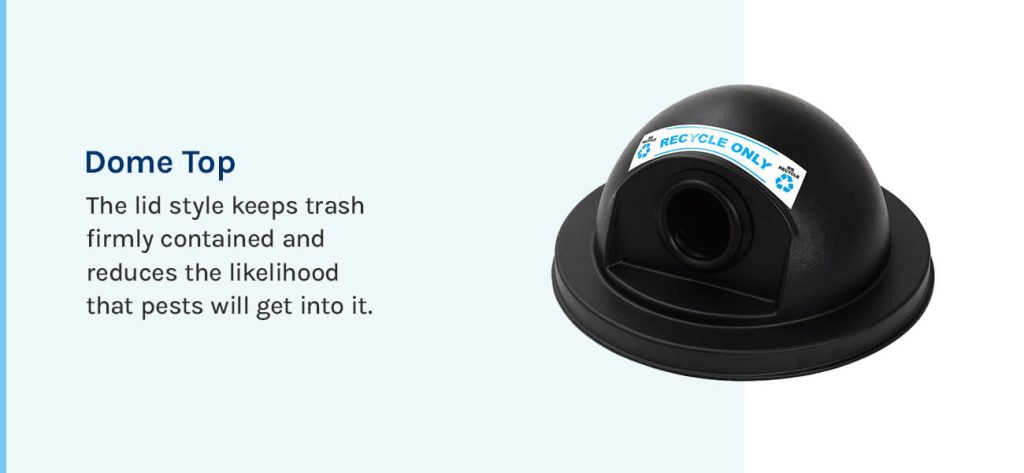
Dome Top
Dome top lids have a rounded top and a flap that people usually need to push open to put their trash inside the receptacle. The lid style keeps trash firmly contained and reduces the likelihood that pests will get into it. Dome tops also protect the receptacle from rain and can keep the wind from blowing litter around.
Some people might hesitate to use a dome-topped trash receptacle, though, because of hygiene concerns. That can lead to higher rates of littering if people decide to toss their trash on the ground.
Since dome-topped lids are touched more often, they might also require more frequent cleaning than other options.
Hooded Top
A hooded top lid is similar to a dome top. But, instead of having a flap that people need to push to put their trash in the bin, the top is open on two sides. A hooded top lid offers the best of both worlds. It allows for easier access, like a flat top. It also protects the bin from water and wind.
A drawback of the hooded top lid style is that it doesn’t keep pests away from the trash. A squirrel can get into the receptacle through the opening.
Rain Bonnet
You can think of a rain bonnet as a type of hat for a trash receptacle. It hovers over the opening of the bin, but still allows access to the receptacle from all sides.
A rain bonnet keeps trash from getting soaked in a rainstorm and also provides some protection against wind. It won’t keep pests from getting into the trash, though.
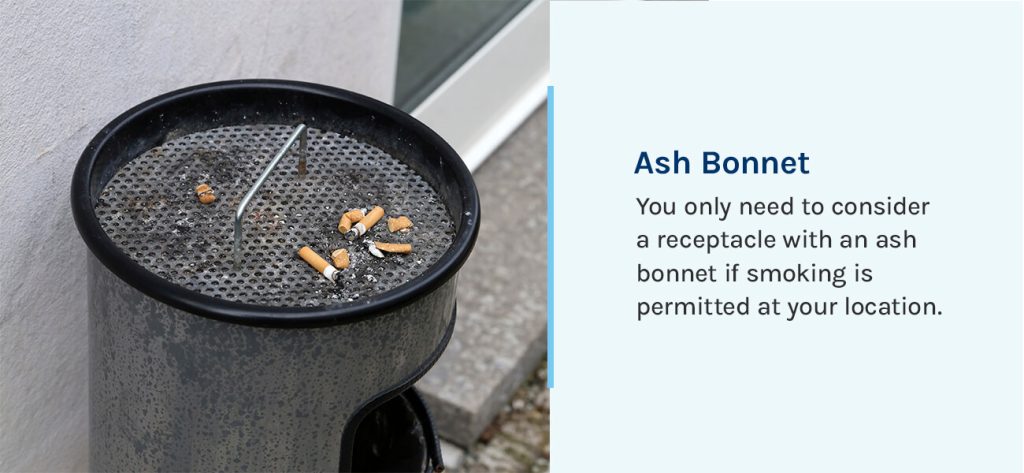
Ash Bonnet
An ash bonnet gives smokers a place to put their cigarette butts that isn’t on the ground or the inside of the trash receptacle itself. The ash bonnet can be filled with sand or made from a fire-resistant material. Encouraging people to put their butts in the ash bonnet helps to lower the risk of a fire in a trash bin.
You only need to consider a receptacle with an ash bonnet if smoking is permitted at your location.
Tray Bonnet
If you operate a restaurant with outdoor seating or an amusement park with a dining area, a tray bonnet lid gives people a place to return their trays once they’ve finished their meals. The bonnet helps to keep reusable trays from being thrown away. It also keeps water out of the trash bins.
Choosing the Right Type of Trash Receptacle for Your Business
There’s no one-size-fits-all option when it comes to choosing trash receptacles. Your business might benefit from picking the same type of receptacle for use all over or choosing different styles to suit different areas. For example, you might choose one style for use by a playground and another for use in a picnic area.
Where you put the receptacles, the weather in your area and how people will use them can also influence your decision.
Location of the Trash Receptacles
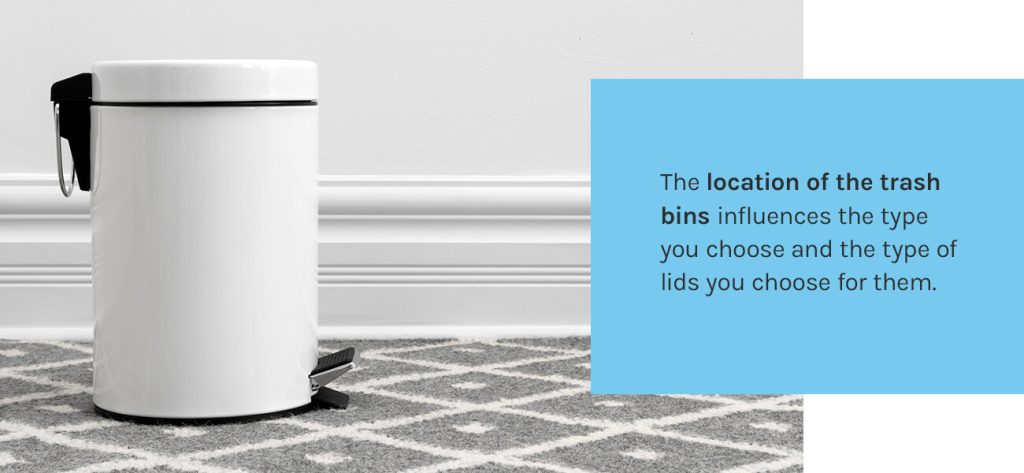
The location of the trash bins influences the type you choose and the type of lids you choose for them. For example, if the receptacles will be in an outdoor area that has a covering, such as underneath an awning or pavilion, protecting the trash from rain or other elements is less of a concern. You might be more likely to choose a flat top receptacle in that case.
But if the receptacles are in an uncovered area or a dining area, choosing a dome top lid might be your best option. The lid will keep odors from getting out of the bins and will also keep rain and pests out.
For an area with a lot of foot traffic, such as a path through a park or a walkway at a sports stadium or amusement park, a flat top lid style receptacle can make sense. That way, people don’t have to slow down or stop to put their trash in the bin.
The location also affects the appearance of the receptacles. For instance, in a playground, you might prefer to install coated metal bins in bright, kid-friendly colors.
Use of the Trash Receptacles
How people will use the trash receptacles contributes to the types you choose. If smoking is allowed at your business, having a few ash urns throughout or installing ash bonnets over the trash receptacles will help to keep cigarette litter to a minimum.
If you’re looking for trash bins for a restaurant, choosing a tray bonnet can be a good call. Similarly, if you’re concerned about odors, a dome top lid and a receptacle made from solid materials, rather than in an open style, can also be a good pick.
Also, consider whether your business collects recycling. If it does, having recycling receptacles next to the trash bins is a smart move. Have as many recycling receptacles as trash bins to encourage people to put their recyclables in the right bin. You should also clearly label the bins so people know which one is for trash and which is for recycling. Using different colors, such as a green or blue receptacle for recycling, is also a good call.
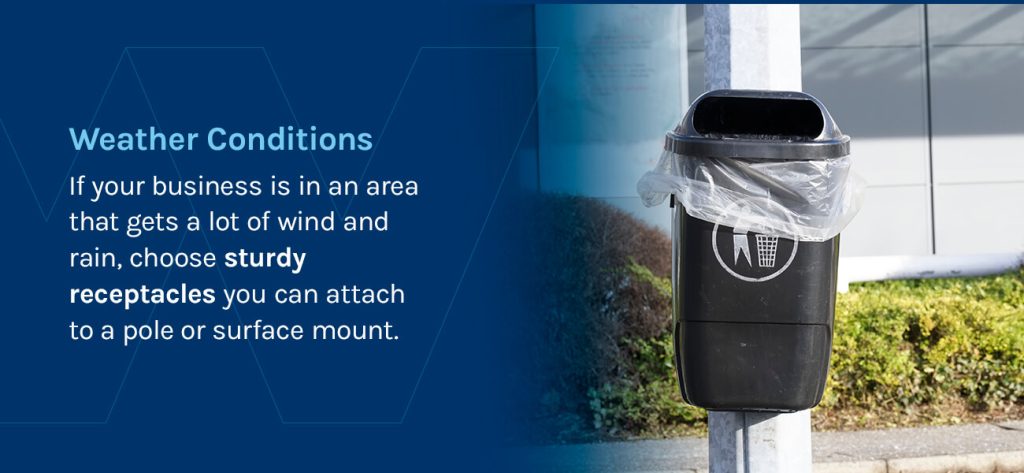
Weather Conditions
The type of weather in your area can affect your choice of trash receptacles. If your business is in an area that gets a lot of wind and rain, choose sturdy receptacles you can attach to a pole or surface mount. Also, pick materials that won’t rust or rot in humid or moist conditions.
Sunlight can also affect the longevity and condition of your trash receptacles. If you’re putting the trash bins in a sunny spot, look for a material that has UV resistance to prevent fading or other damage.
Foot Traffic
Consider the number of people in and out of your business daily when choosing receptacle sizes. If there’s not much foot traffic, smaller bins can be sufficient. But if many people come and go and have a lot of trash, the bigger the bin, the better. With a bigger bin, there’s less chance that it will overflow before an employee can empty it. Larger bins also need to be emptied fewer times per day, meaning your team can focus on more pressing tasks.
Number of Trash Receptacles
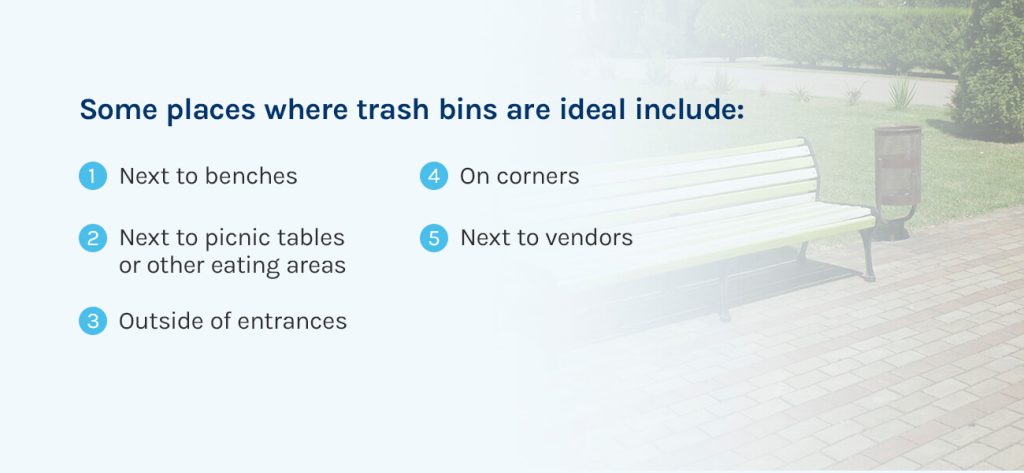
Usually, the more trash receptacles your business has, the better. People are less likely to litter if they can easily get to a trash bin. Some places where trash bins are ideal include:
- Next to benches
- Next to picnic tables or other eating areas
- Outside of entrances
- On corners
- Next to food vendors
Ideally, trash receptacles at your business won’t be more than 10 to 25 feet apart. The farther a person has to walk while carrying a piece of garbage, the more likely they are to drop it.
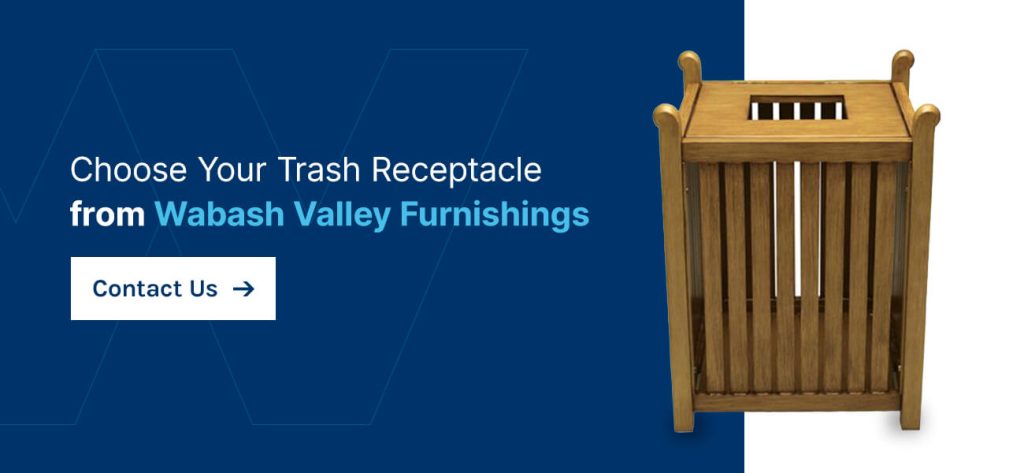
Choose Your Trash Receptacle from Wabash Valley Furnishings
Wabash Valley Furnishings has outdoor trash receptacles to suit the needs of various businesses. Whether you’re looking for flat top or lidded models, need surface- or pole-mounted receptacles or want something colorful or rustic, you’ll find it. To learn more, browse our products today. You can also contact us for a quote.
Categories
Recent Posts
Sign up for our newsletter
Share this post:

